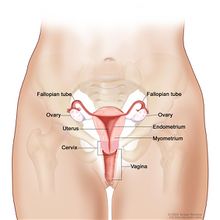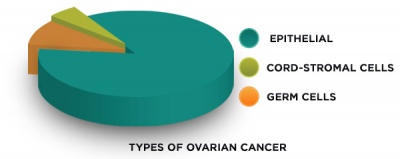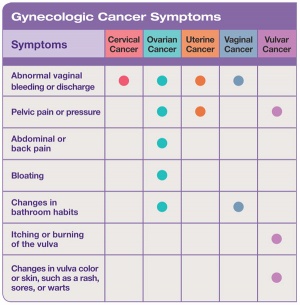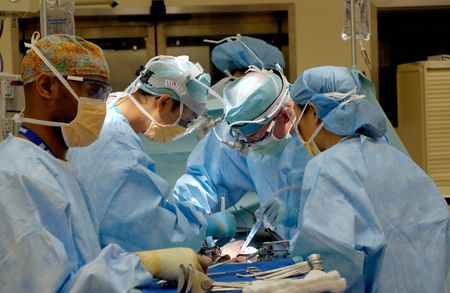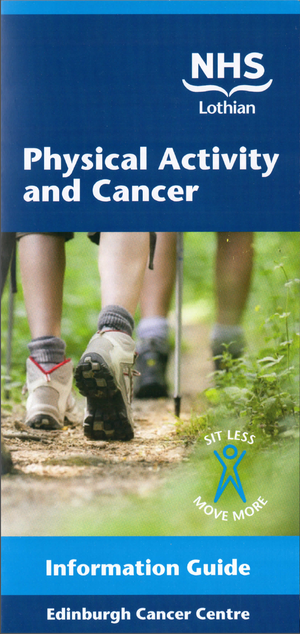Ovarian Cancer: Difference between revisions
No edit summary |
No edit summary |
||
| (122 intermediate revisions by 10 users not shown) | |||
| Line 1: | Line 1: | ||
<div class="editorbox"> | |||
'''Original Editors '''- Trisha Counce & Brandy Hirsch [[Pathophysiology of Complex Patient Problems|from Bellarmine University's Pathophysiology of Complex Patient Problems project.]] | '''Original Editors '''- Trisha Counce & Brandy Hirsch [[Pathophysiology of Complex Patient Problems|from Bellarmine University's Pathophysiology of Complex Patient Problems project.]] | ||
| Line 5: | Line 5: | ||
</div> | </div> | ||
== Definition/Description == | == Definition/Description == | ||
[[File:Ovarian_cancer.jpg|right|frameless|220x220px]] | |||
Ovarian [[Oncology|cancer]] (OC) is one of the most common gynecologic cancers that has the highest mortality rate.<ref name=":0">Momenimovahed Z, Tiznobaik A, Taheri S, Salehiniya H. [https://www.ncbi.nlm.nih.gov/pmc/articles/PMC6500433/ Ovarian cancer in the world: epidemiology and risk factors]. International journal of women's health. 2019;11:287.</ref> | |||
The term "ovarian cancer" encompasses several types of cancer that all arise from cells of the ovaries in the female reproductive system | The term "ovarian cancer" encompasses several types of cancer that all arise from the cells of the ovaries in the female reproductive system.<ref name="Green">Green A. Ovarian Cancer (Cancer of the Ovaries). MedicineNet.com. http://www.medicinenet.com/ovarian_cancer/article.htm. Updated September 24, 2013. Accessed March 12, 2014.</ref> | ||
Ovarian cancer commonly manifests as three different types | |||
# [[File:Types_Chart.jpg|right|frameless|400x400px]]Epithelial - derived from the cells on the surface of the ovary or fallopian tube, accounts for about 70% of all ovarian cancers, making it the most common type.<ref name="Green" /> | |||
2. Germ cell - derived from the cells that produce eggs | |||
3. Cord-stromal cell - derived from the connective tissue within the ovary<ref name="Med Info">Medical Information. National Ovarian Cancer Coalition. http://ovarian.org/what_is_ovarian_cancer.php. Accessed March 12, 2014.</ref> | |||
< | == Stages == | ||
# '''Stage I '''- Growth of the cancer is limited to the ovary or ovaries. | |||
# '''Stage II '''- Growth of the cancer involves one or both ovaries with pelvic extension. | |||
# '''Stage III''' - Growth of the cancer involves one or both ovaries, and one or both of the following are present: (1) the cancer has spread beyond the pelvis to the lining of the abdomen; and (2) the cancer has spread to lymph nodes. The tumor is limited to the true pelvis but with histologically proven malignant extension to the small bowel or omentum. | |||
#[[File:Stages_cancer.jpg|right|frameless|920x920px]]'''Stage IV''' - This is the most advanced stage of ovarian cancer. Growth of the cancer involves one or both ovaries and distant metastases (spread of cancer to organs located outside of the peritoneal cavity) have occurred. Finding ovarian cancer cells in pleural fluid (from the cavity which surrounds the lungs) is also evidence of stage IV disease<ref name="Med Info" />. | |||
Risk of Recurrence: | |||
*Patients diagnosed in '''stage I''' have a '''10''' percent chance of recurrence. | |||
*Patients diagnosed in '''stage II''' have a '''30 '''percent chance of recurrence. | |||
*Patients diagnosed in '''stage III '''have a '''70 to 90''' percent chance of recurrence. | |||
*Patients diagnosed in '''stage IV '''have a '''90 to 95''' percent chance of recurrence'''<ref name="Gov">Ovarian Cancer. National Cancer Institute. http://www.cancer.gov/cancertopics/types/ovarian. Accessed March 12, 2014.</ref>'''. | |||
== Prevalence and Incidence == | |||
Population growth, increased risk factors for cancer, decreased pregnancy and duration of lactation, and tube ligation, have led to an upward trend in the incidence of Ovarian Cancer around the world. | |||
* | * It is the fifth most common cause of death from cancer in women and is the most lethal of all gynaecological cancers. | ||
* | * The lifetime risk of a woman developing ovarian cancer is 1 in 71, and 1 in 200 women will develop ovarian cancer between their 50th and 70th birthday. | ||
* | * Ninety percent of all deaths from ovarian cancer are due to high-grade serous cancer, and this cancer sub-type accounts for 75% of all cases<ref name=":1">Xian W, George S. [https://ijgc.bmj.com/content/29/Suppl_2/s2.abstract Meeting report from the 2018 12th biennial ovarian cancer research symposium detection and prevention of ovarian cancer]. International Journal of Gynecologic Cancer. 2019 Aug 1;29(Suppl 2).</ref>. | ||
* Worldwide, 295,414 cases of ovarian cancer have been identified in 2018, accounting for 3.4% of all cancer cases in women. | |||
The incidence of epithelial ovarian cancers varies in different age and race groups. | |||
* | * Higher among transitioned countries | ||
* | * Approximately 30% of ovarian cancer cases occur in European countries | ||
* | * In 2012, the highest rates of ovarian cancer occurred in China (14.60% of all cases), India (11.33% of all cases), and the US (81.8% of all cases). | ||
* | * In 2012 that year, 22,240 cases of ovarian cancer were detected in the US alone. | ||
* Among the Asian countries, Singapore, Kazakhstan, and Brunei have the highest standardized incidence rate of ovarian cancer | |||
Considering the heavy burden of ovarian cancer on women's health, preventive measures, as well as health education and early detection in high-risk groups of women are highly recommended. Although some risk factors cannot be changed, a focus on preventable risk factors may reduce the risk of ovarian cancer.<ref name=":0" /> | |||
== Mortality == | |||
In 2018, 184,799 deaths occurred due to ovarian cancer, accounting for 4.4% of the entire cancer-related mortality among women. | |||
* The incidence of cancer is higher among high Human Development Index (HDI) countries however the trend of mortality rate tends to be the reverse | |||
* The highest mortality rate in Asia is seen in India, and the mortality rate has decreased in Europe and North America in recent years, especially among young people. | |||
* The mortality-to-incidence ratio is high among African women, indicating their lack of access to suitable treatment. | |||
* Two-thirds of ovarian cancer mortality is attributable to high-grade serous carcinoma<ref name=":0" />. | |||
== | == Etiology/Risk Factors == | ||
General risk factors include: | |||
* Nulliparity | |||
* Middle-aged (50) or older <ref name="CDC" /> | |||
* Early menopause | |||
* Gonadal dysgenesis | |||
* Family history: contributes to 24% of cases of epithelial ovarian cancer | |||
** BRCA1/BRCA2 mutations: particularly for serous types | |||
** Lynch syndrome-associated ovarian cancers most often have an endometrioid or serous type histology | |||
* Smoking: especially for mucinous adenocarcinoma | |||
* Previous history of breast, endometrial or colon cancer | |||
* Certain ethnic groups | |||
* Use of fertility drugs: There is mixed evidence with some studies finding associations between fertility drug use and cancer risks while others not. An old review of literature<ref>Eva Glud,Susanne Kriiger Kjaer, Rebecca Troisi,and Louise A. Brinton. [https://www.physio-pedia.com/images/3/36/Fertility_and_ovarian_cancer.pdf Fertility Drugs and Ovarian Cancer], | |||
Epidemiologic Reviews, Vol 20,No. 2.The Johns Hopkins University School of Hygiene and Public Health.</ref> could not draw conclusion on the association between use of fertility drugs and risk of ovarian cancer due to insufficient data. However a cohort study (2017) found elevated risk of endometrial cancers in women exposed to clomiphene citrate (fertility drug)<ref>Reigstad MM, Storeng R, Myklebust TÅ, Oldereid NB, Omland AK, Robsahm TE, Brinton LA, Vangen S, Furu K, Larsen IK. [https://europepmc.org/backend/ptpmcrender.fcgi?accid=PMC5457348&blobtype=pdf Cancer risk in women treated with fertility drugs according to parity status—a registry-based cohort study.] Cancer Epidemiology, Biomarkers & Prevention. 2017 Jun;26(6):953-62.</ref>. | |||
* Protective factors: | |||
** Oral contraceptives | |||
** Breastfeeding (this is controversial)<ref>Radiopedia [https://radiopaedia.org/articles/ovarian-tumours OC] Available from:https://radiopaedia.org/articles/ovarian-tumours (last accessed 2.9.2020)</ref> | |||
== | == Characteristics/Clinical Presentation == | ||
[[File:Gynecological_cancer_symptoms.jpg|right|frameless]] | |||
Epithelial ovarian cancer presents with a wide variety of vague and nonspecific symptoms.<ref name="Medscape">Green A. Ovarian Cancer. Medscape. http://emedicine.medscape.com/article/255771-overview#a0101. Published 1994-2014. Updated March 10, 2014. Accessed March 12, 2014.</ref> Ovarian cancer may cause one or more of these signs and symptoms-- | |||
* Bloating, which is when the area below your stomach swells or feels full <ref name="Medscape" /><ref name="CDC" /><ref name="Mayo">Mayo Clinic Staff. Diseases and Conditions Ovarian Cancer. http://www.mayoclinic.org/diseases-conditions/ovarian-cancer/basics/definition/con-20028096. Published 1998-2014. Updated November 10, 2012. Accessed March 12, 2014.</ref> | |||
* Vaginal bleeding or discharge (not normal for individual) <ref name="CDC" /><ref name="Medscape" /> | |||
== | * Pain in the pelvic or abdominal area, abdominal distension or discomfort, abdominal mass <ref name="CDC" /><ref name="Medscape" /> | ||
* Back pain <ref name="CDC" /><ref name="Mayo" /> | |||
* Feeling full quickly while eating <ref name="CDC" /><ref name="Medscape" /><ref name="Mayo" /> | |||
* Painful urination or frequent urges, constipation, or diarrhea <ref name="CDC">Ovarian Cancer. Center for Disease Control and Prevention. http://www.cdc.gov/cancer/ovarian/index.htm. Updated June 17, 2013. Accessed March 12, 2014.&lt;/ref&gt;</ref><ref name="Mayo" /> | |||
* Indigestion and acid reflux <ref name="Medscape" /> | |||
* Shortness of breath (SOB) <ref name="Medscape" /> | |||
* Weight Loss | |||
* Persistent lack of energy <ref name="Mayo" /> | |||
== [[Oncology Medical Management|Treatment]] == | |||
[[File:Surgery abdo.jpg|right|frameless|450x450px]] | |||
Ovarian cancer is the deadliest gynecologic malignancy in the United States. | |||
* Evidence-based interventions for the prevention and early detection of ovarian cancer do not currently exist. | |||
* Several treatment guidelines, including the receipt of treatment from a gynecologic oncologist, have been shown to result in improved survival from ovarian cancer.<ref>Stewart SL, Rim SH, Richards TB. [https://www.liebertpub.com/doi/abs/10.1089/jwh.2011.3053 Gynecologic oncologists and ovarian cancer treatment: avenues for improved survival. Journal of women's health]. 2011 Sep 1;20(9):1257-60.</ref> | |||
Progress in the treatment of ovarian cancer has been exponential over the last decade, with a flurry of new experimental targeted agents and new drug approvals. With new opportunities come new challenges with regard to what agents to select, how best to evaluate those agents, and how best to identify optimal treatment regimens and improve patient outcomes.<ref>Lee JM, Minasian L, Kohn EC. [https://acsjournals.onlinelibrary.wiley.com/doi/abs/10.1002/cncr.32544 New strategies in ovarian cancer treatment]. Cancer. 2019 Dec 15;125:4623-9.</ref> | |||
Surgery, chemotherapy, and radiation may be used to treat ovarian cancer, depending on the disease’s stage | |||
# Surgery - This is usually the first step. How much surgery you have depends on how far the cancer has spread. In some cases, the ovaries, uterus, cervix, or fallopian tubes may need to be removed. Other tissue typically removed includes lymph nodes, the omentum (fatty apron covering the intestines) and all visible cancer. | |||
2. [[Chemotherapy Side Effects and Syndromes|Chemotherapy]] - usually receive through an IV. However, sometimes they work better for ovarian cancer if they’re injected into the abdomen. | |||
3. [[Radiation Side Effects and Syndromes|Radiation]] - It can be used if cancer has come back after treatment or to help control symptoms like pain. | |||
4. Targeted Therapy - These treatments use newer medications that find and attack cancer cells while doing little damage to surrounding normal cells. These meds all work in different ways, but they’re able to stop cancer cells from growing, dividing, or fixing themselves. The medications are either taken by mouth or given by IV. | |||
5. Hormone Therapy - In some cases, doctors might suggest using hormones or hormone-blocking medications. According to the American Cancer Society, this therapy is most often used to treat ovarian stromal tumors, not epithelial ovarian cancer<ref>Webmd [https://www.webmd.com/ovarian-cancer/guide/understanding-ovarian-cancer-treatment Treatment for OC] Available from:https://www.webmd.com/ovarian-cancer/guide/understanding-ovarian-cancer-treatment (last accessed 2.9.2020)</ref> | |||
== | == Diagnostic Tests == | ||
There are currently no reliable screening tools available to diagnose ovarian cancer. | |||
* One goal of all cancer therapy is to provide early screening and pre-emptive intervention to avoid the challenges presented by highly metastatic cancers. The stages of cancer have a huge influence on the outcome. Early diagnosis of cancer will fundamentally affect the management of these tumors.<ref name=":1" /> | |||
* The current recommendations include an annual pelvic exam, transvaginal ultrasound, and CA-125 blood test.<ref name="Institute">Ovarian Cancer Institute. http://ovariancancerinstitute.org. Published 2014. Accessed March 12, 2014.</ref> | |||
* These are the best options for screening but even in combination, results have been found to be unreliable. | |||
== Physical Therapy Management | == [[Oncology Physiotherapy Management|Physical Therapy Management]] == | ||
[[File:Exercise home.jpg|right|frameless]] | |||
Although there are no specific physical therapy protocols for ovarian cancer, evidence supports the benefits of physical therapy in improving [[Activities of Daily Living|daily function]], [[Quality of Life|quality of life]], and health in patients with cancer. | |||
* <span style="line-height: 1.5em;">Each person’s exercise program should be based on what is safe and what works best for them. It should also be something they like doing. </span> | |||
* <span style="line-height: 1.5em;">The exercise plan should take into account any exercise program already followed, what they can do now, and any physical problems or limits. </span><ref name="Cancer.org">Physical Activity and the Cancer Patient. American Cancer Society. http://www.cancer.org/treatment/survivorshipduringandaftertreatment/stayingactive/physical-activity-and-the-cancer-patient. Published 2014. Updated February 6, 2013. Accessed March 12, 2014.</ref> | |||
* <span style="line-height: 1.5em;">These therapeutic exercises aim to reduce fatigue and optimize physical function, safety and well-being. </span><ref>Oncology Rehabilitation for Ovarian Cancer. Cancer Treatment Centers of America. http://www.cancercenter.com/ovarian-cancer/oncology-rehabilitation/. Published 2014. Accessed March 12, 2014.</ref><span style="line-height: 1.5em;"> </span> | |||
<span style="line-height: 1.5em;"></span>'''An exercises regimen could include:''' | |||
*<span style="line-height: 1.5em;">Range-of-motion training with <ref name="cancercenter">Oncology Rehabilitation for Ovarian Cancer. Cancer Treatment Centers of America. http://www.cancercenter.com/ovarian-cancer/oncology-rehabilitation/. Published 2014. Accessed March 12, 2014.</ref> </span> | |||
*<span style="line-height: 1.5em;">Light resistance exercises <ref name="cancercenter" /></span> | |||
*<span style="line-height: 1.5em;">[[Cardiovascular Exercises For Elderly|Cardiovascular]] activity <ref name="cancercompass">Physical Therapy. Cancer Compass. http://www.cancercompass.com/cancer-treatment/physical-therapy.htm. Published 2014. Accessed March 12, 2014.</ref></span> | |||
*<span style="line-height: 1.5em;">Flexibility exercises <ref name="cancercompass" /></span> | |||
*<span style="line-height: 1.5em;">[[Strength and Conditioning|Strength]] training <ref name="cancercompass" /></span> | |||
== | <span style="line-height: 1.5em;">Exercise, even minimal physical exertion, </span><span style="line-height: 1.5em;">increases heart rate and muscle flexion while boosting</span> <span style="line-height: 1.5em;">the</span> <span style="line-height: 1.5em;">body’s tolerance to chemotherapy and radiation treatments. Participating in daily exercise programs enables client to gain a sense of physical control over</span> <span style="line-height: 1.5em;">the</span> <span style="line-height: 1.5em;">condition, and provide an outlet for stress and anxiety. <ref name="cancercenter" /></span><span style="line-height: 1.5em;"></span> | ||
<span style="line-height: 1.5em;"><span> </span></span>'''<span style="line-height: 1.5em;">Physical therapy also provides:</span>''' | |||
== | *<span style="line-height: 1.5em;">[[Massage]] Therapy, which recent studies show can decrease [[Stress and Health|stress]], anxiety, [[depression]], and [[Pain Behaviours|pain]], and increase alertness <ref name="cancercompass" /></span> | ||
*[[Lymphoedema|Lymphedema]] Therapy eg [[Manual Lymphatic Drainage|MLD]] | |||
*Self-Care Management to improve an individuals ability to return to their home | |||
'''The American Cancer Society outlines the following for [[Physical Activity|physical activity]] after cancer treatment. <ref name="ACS">Ovarian Cancer Overview. American Cancer Society. http://www.cancer.org/acs/groups/cid/documents/webcontent/003070-pdf.pdf. Published 2013. Updated February 6, 2014. Accessed March 12, 2014.</ref>''' | |||
[[File:Physical activity ca NHSLothian.png|right|frameless]] | |||
'''When you are recovering from cancer treatment''' | |||
= | *'''<span> </span>'''<span style="line-height: 1.5em;">Many side effects get better within a few weeks after cancer treatment ends, but some can last much longer or even emerge later. Most people are able to slowly increase exercise time and intensity.</span> | ||
*What may be a low- or moderate-intensity activity for a healthy person may seem like a high-intensity activity for some cancer survivors. | |||
'''When you are living disease-free or with stable disease''' | |||
*<span> During this phase, physical activity is important to your overall health and quality of life. It may even help some people live longer. There’s some evidence that getting to and staying at a healthy weight, eating right, and being physically active may help reduce risk of second cancer as well as other serious chronic diseases. More research is needed to be sure about these possible benefits.</span> | |||
'''The American Cancer Society recommends that cancer survivors take these actions''' | |||
*Take part in regular physical activity. | |||
*Avoid inactivity and return to normal daily activities as soon as possible after diagnosis. | |||
*Aim to exercise at least 150 minutes per week. | |||
*Include strength training exercises at least 2 days per week. | |||
A growing number of studies have looked at the impact of physical activity on cancer recurrence and long-term survival. Exercise has been shown to improve cardiovascular fitness, muscle strength, body composition, fatigue, anxiety, depression, self-esteem, happiness, and several quality of life factors in cancer survivors. <br>'''Living with advanced cancer''' | |||
*Some level of physical activity can improve quality of life for people with certain types of cancer, even if the disease is advanced (has spread to many places and/or is no longer responding to treatment). But this varies by cancer type, physical ability, health problems related to the cancer or cancer treatment, and other illnesses. The situation can also change quickly for a person with advanced cancer, and physical activity should be based on the person’s goals, abilities, and preferences. | |||
== References == | == References == | ||
<references /> | <references /> | ||
[[Category:Bellarmine_Student_Project]] | [[Category:Bellarmine_Student_Project]] | ||
[[Category:Oncology]] | |||
[[Category:Womens Health]] | |||
Latest revision as of 17:05, 17 January 2023
Original Editors - Trisha Counce & Brandy Hirsch from Bellarmine University's Pathophysiology of Complex Patient Problems project.
Top Contributors - Brandy Hirsch, Trisha Counce, Lucinda hampton, Aminat Abolade, Vidya Acharya, Elaine Lonnemann, WikiSysop, Kim Jackson, 127.0.0.1, Wendy Walker and Rishika Babburu
Definition/Description[edit | edit source]
Ovarian cancer (OC) is one of the most common gynecologic cancers that has the highest mortality rate.[1]
The term "ovarian cancer" encompasses several types of cancer that all arise from the cells of the ovaries in the female reproductive system.[2]
Ovarian cancer commonly manifests as three different types
- Epithelial - derived from the cells on the surface of the ovary or fallopian tube, accounts for about 70% of all ovarian cancers, making it the most common type.[2]
2. Germ cell - derived from the cells that produce eggs
3. Cord-stromal cell - derived from the connective tissue within the ovary[3]
Stages [edit | edit source]
- Stage I - Growth of the cancer is limited to the ovary or ovaries.
- Stage II - Growth of the cancer involves one or both ovaries with pelvic extension.
- Stage III - Growth of the cancer involves one or both ovaries, and one or both of the following are present: (1) the cancer has spread beyond the pelvis to the lining of the abdomen; and (2) the cancer has spread to lymph nodes. The tumor is limited to the true pelvis but with histologically proven malignant extension to the small bowel or omentum.
- Stage IV - This is the most advanced stage of ovarian cancer. Growth of the cancer involves one or both ovaries and distant metastases (spread of cancer to organs located outside of the peritoneal cavity) have occurred. Finding ovarian cancer cells in pleural fluid (from the cavity which surrounds the lungs) is also evidence of stage IV disease[3].
Risk of Recurrence:
- Patients diagnosed in stage I have a 10 percent chance of recurrence.
- Patients diagnosed in stage II have a 30 percent chance of recurrence.
- Patients diagnosed in stage III have a 70 to 90 percent chance of recurrence.
- Patients diagnosed in stage IV have a 90 to 95 percent chance of recurrence[4].
Prevalence and Incidence [edit | edit source]
Population growth, increased risk factors for cancer, decreased pregnancy and duration of lactation, and tube ligation, have led to an upward trend in the incidence of Ovarian Cancer around the world.
- It is the fifth most common cause of death from cancer in women and is the most lethal of all gynaecological cancers.
- The lifetime risk of a woman developing ovarian cancer is 1 in 71, and 1 in 200 women will develop ovarian cancer between their 50th and 70th birthday.
- Ninety percent of all deaths from ovarian cancer are due to high-grade serous cancer, and this cancer sub-type accounts for 75% of all cases[5].
- Worldwide, 295,414 cases of ovarian cancer have been identified in 2018, accounting for 3.4% of all cancer cases in women.
The incidence of epithelial ovarian cancers varies in different age and race groups.
- Higher among transitioned countries
- Approximately 30% of ovarian cancer cases occur in European countries
- In 2012, the highest rates of ovarian cancer occurred in China (14.60% of all cases), India (11.33% of all cases), and the US (81.8% of all cases).
- In 2012 that year, 22,240 cases of ovarian cancer were detected in the US alone.
- Among the Asian countries, Singapore, Kazakhstan, and Brunei have the highest standardized incidence rate of ovarian cancer
Considering the heavy burden of ovarian cancer on women's health, preventive measures, as well as health education and early detection in high-risk groups of women are highly recommended. Although some risk factors cannot be changed, a focus on preventable risk factors may reduce the risk of ovarian cancer.[1]
Mortality[edit | edit source]
In 2018, 184,799 deaths occurred due to ovarian cancer, accounting for 4.4% of the entire cancer-related mortality among women.
- The incidence of cancer is higher among high Human Development Index (HDI) countries however the trend of mortality rate tends to be the reverse
- The highest mortality rate in Asia is seen in India, and the mortality rate has decreased in Europe and North America in recent years, especially among young people.
- The mortality-to-incidence ratio is high among African women, indicating their lack of access to suitable treatment.
- Two-thirds of ovarian cancer mortality is attributable to high-grade serous carcinoma[1].
Etiology/Risk Factors[edit | edit source]
General risk factors include:
- Nulliparity
- Middle-aged (50) or older [6]
- Early menopause
- Gonadal dysgenesis
- Family history: contributes to 24% of cases of epithelial ovarian cancer
- BRCA1/BRCA2 mutations: particularly for serous types
- Lynch syndrome-associated ovarian cancers most often have an endometrioid or serous type histology
- Smoking: especially for mucinous adenocarcinoma
- Previous history of breast, endometrial or colon cancer
- Certain ethnic groups
- Use of fertility drugs: There is mixed evidence with some studies finding associations between fertility drug use and cancer risks while others not. An old review of literature[7] could not draw conclusion on the association between use of fertility drugs and risk of ovarian cancer due to insufficient data. However a cohort study (2017) found elevated risk of endometrial cancers in women exposed to clomiphene citrate (fertility drug)[8].
- Protective factors:
- Oral contraceptives
- Breastfeeding (this is controversial)[9]
Characteristics/Clinical Presentation[edit | edit source]
Epithelial ovarian cancer presents with a wide variety of vague and nonspecific symptoms.[10] Ovarian cancer may cause one or more of these signs and symptoms--
- Bloating, which is when the area below your stomach swells or feels full [10][6][11]
- Vaginal bleeding or discharge (not normal for individual) [6][10]
- Pain in the pelvic or abdominal area, abdominal distension or discomfort, abdominal mass [6][10]
- Back pain [6][11]
- Feeling full quickly while eating [6][10][11]
- Painful urination or frequent urges, constipation, or diarrhea [6][11]
- Indigestion and acid reflux [10]
- Shortness of breath (SOB) [10]
- Weight Loss
- Persistent lack of energy [11]
Treatment[edit | edit source]
Ovarian cancer is the deadliest gynecologic malignancy in the United States.
- Evidence-based interventions for the prevention and early detection of ovarian cancer do not currently exist.
- Several treatment guidelines, including the receipt of treatment from a gynecologic oncologist, have been shown to result in improved survival from ovarian cancer.[12]
Progress in the treatment of ovarian cancer has been exponential over the last decade, with a flurry of new experimental targeted agents and new drug approvals. With new opportunities come new challenges with regard to what agents to select, how best to evaluate those agents, and how best to identify optimal treatment regimens and improve patient outcomes.[13]
Surgery, chemotherapy, and radiation may be used to treat ovarian cancer, depending on the disease’s stage
- Surgery - This is usually the first step. How much surgery you have depends on how far the cancer has spread. In some cases, the ovaries, uterus, cervix, or fallopian tubes may need to be removed. Other tissue typically removed includes lymph nodes, the omentum (fatty apron covering the intestines) and all visible cancer.
2. Chemotherapy - usually receive through an IV. However, sometimes they work better for ovarian cancer if they’re injected into the abdomen.
3. Radiation - It can be used if cancer has come back after treatment or to help control symptoms like pain.
4. Targeted Therapy - These treatments use newer medications that find and attack cancer cells while doing little damage to surrounding normal cells. These meds all work in different ways, but they’re able to stop cancer cells from growing, dividing, or fixing themselves. The medications are either taken by mouth or given by IV.
5. Hormone Therapy - In some cases, doctors might suggest using hormones or hormone-blocking medications. According to the American Cancer Society, this therapy is most often used to treat ovarian stromal tumors, not epithelial ovarian cancer[14]
Diagnostic Tests[edit | edit source]
There are currently no reliable screening tools available to diagnose ovarian cancer.
- One goal of all cancer therapy is to provide early screening and pre-emptive intervention to avoid the challenges presented by highly metastatic cancers. The stages of cancer have a huge influence on the outcome. Early diagnosis of cancer will fundamentally affect the management of these tumors.[5]
- The current recommendations include an annual pelvic exam, transvaginal ultrasound, and CA-125 blood test.[15]
- These are the best options for screening but even in combination, results have been found to be unreliable.
Physical Therapy Management[edit | edit source]
Although there are no specific physical therapy protocols for ovarian cancer, evidence supports the benefits of physical therapy in improving daily function, quality of life, and health in patients with cancer.
- Each person’s exercise program should be based on what is safe and what works best for them. It should also be something they like doing.
- The exercise plan should take into account any exercise program already followed, what they can do now, and any physical problems or limits. [16]
- These therapeutic exercises aim to reduce fatigue and optimize physical function, safety and well-being. [17]
An exercises regimen could include:
- Range-of-motion training with [18]
- Light resistance exercises [18]
- Cardiovascular activity [19]
- Flexibility exercises [19]
- Strength training [19]
Exercise, even minimal physical exertion, increases heart rate and muscle flexion while boosting the body’s tolerance to chemotherapy and radiation treatments. Participating in daily exercise programs enables client to gain a sense of physical control over the condition, and provide an outlet for stress and anxiety. [18]
Physical therapy also provides:
- Massage Therapy, which recent studies show can decrease stress, anxiety, depression, and pain, and increase alertness [19]
- Lymphedema Therapy eg MLD
- Self-Care Management to improve an individuals ability to return to their home
The American Cancer Society outlines the following for physical activity after cancer treatment. [20]
When you are recovering from cancer treatment
- Many side effects get better within a few weeks after cancer treatment ends, but some can last much longer or even emerge later. Most people are able to slowly increase exercise time and intensity.
- What may be a low- or moderate-intensity activity for a healthy person may seem like a high-intensity activity for some cancer survivors.
When you are living disease-free or with stable disease
- During this phase, physical activity is important to your overall health and quality of life. It may even help some people live longer. There’s some evidence that getting to and staying at a healthy weight, eating right, and being physically active may help reduce risk of second cancer as well as other serious chronic diseases. More research is needed to be sure about these possible benefits.
The American Cancer Society recommends that cancer survivors take these actions
- Take part in regular physical activity.
- Avoid inactivity and return to normal daily activities as soon as possible after diagnosis.
- Aim to exercise at least 150 minutes per week.
- Include strength training exercises at least 2 days per week.
A growing number of studies have looked at the impact of physical activity on cancer recurrence and long-term survival. Exercise has been shown to improve cardiovascular fitness, muscle strength, body composition, fatigue, anxiety, depression, self-esteem, happiness, and several quality of life factors in cancer survivors.
Living with advanced cancer
- Some level of physical activity can improve quality of life for people with certain types of cancer, even if the disease is advanced (has spread to many places and/or is no longer responding to treatment). But this varies by cancer type, physical ability, health problems related to the cancer or cancer treatment, and other illnesses. The situation can also change quickly for a person with advanced cancer, and physical activity should be based on the person’s goals, abilities, and preferences.
References[edit | edit source]
- ↑ 1.0 1.1 1.2 Momenimovahed Z, Tiznobaik A, Taheri S, Salehiniya H. Ovarian cancer in the world: epidemiology and risk factors. International journal of women's health. 2019;11:287.
- ↑ 2.0 2.1 Green A. Ovarian Cancer (Cancer of the Ovaries). MedicineNet.com. http://www.medicinenet.com/ovarian_cancer/article.htm. Updated September 24, 2013. Accessed March 12, 2014.
- ↑ 3.0 3.1 Medical Information. National Ovarian Cancer Coalition. http://ovarian.org/what_is_ovarian_cancer.php. Accessed March 12, 2014.
- ↑ Ovarian Cancer. National Cancer Institute. http://www.cancer.gov/cancertopics/types/ovarian. Accessed March 12, 2014.
- ↑ 5.0 5.1 Xian W, George S. Meeting report from the 2018 12th biennial ovarian cancer research symposium detection and prevention of ovarian cancer. International Journal of Gynecologic Cancer. 2019 Aug 1;29(Suppl 2).
- ↑ 6.0 6.1 6.2 6.3 6.4 6.5 6.6 Ovarian Cancer. Center for Disease Control and Prevention. http://www.cdc.gov/cancer/ovarian/index.htm. Updated June 17, 2013. Accessed March 12, 2014.</ref>
- ↑ Eva Glud,Susanne Kriiger Kjaer, Rebecca Troisi,and Louise A. Brinton. Fertility Drugs and Ovarian Cancer, Epidemiologic Reviews, Vol 20,No. 2.The Johns Hopkins University School of Hygiene and Public Health.
- ↑ Reigstad MM, Storeng R, Myklebust TÅ, Oldereid NB, Omland AK, Robsahm TE, Brinton LA, Vangen S, Furu K, Larsen IK. Cancer risk in women treated with fertility drugs according to parity status—a registry-based cohort study. Cancer Epidemiology, Biomarkers & Prevention. 2017 Jun;26(6):953-62.
- ↑ Radiopedia OC Available from:https://radiopaedia.org/articles/ovarian-tumours (last accessed 2.9.2020)
- ↑ 10.0 10.1 10.2 10.3 10.4 10.5 10.6 Green A. Ovarian Cancer. Medscape. http://emedicine.medscape.com/article/255771-overview#a0101. Published 1994-2014. Updated March 10, 2014. Accessed March 12, 2014.
- ↑ 11.0 11.1 11.2 11.3 11.4 Mayo Clinic Staff. Diseases and Conditions Ovarian Cancer. http://www.mayoclinic.org/diseases-conditions/ovarian-cancer/basics/definition/con-20028096. Published 1998-2014. Updated November 10, 2012. Accessed March 12, 2014.
- ↑ Stewart SL, Rim SH, Richards TB. Gynecologic oncologists and ovarian cancer treatment: avenues for improved survival. Journal of women's health. 2011 Sep 1;20(9):1257-60.
- ↑ Lee JM, Minasian L, Kohn EC. New strategies in ovarian cancer treatment. Cancer. 2019 Dec 15;125:4623-9.
- ↑ Webmd Treatment for OC Available from:https://www.webmd.com/ovarian-cancer/guide/understanding-ovarian-cancer-treatment (last accessed 2.9.2020)
- ↑ Ovarian Cancer Institute. http://ovariancancerinstitute.org. Published 2014. Accessed March 12, 2014.
- ↑ Physical Activity and the Cancer Patient. American Cancer Society. http://www.cancer.org/treatment/survivorshipduringandaftertreatment/stayingactive/physical-activity-and-the-cancer-patient. Published 2014. Updated February 6, 2013. Accessed March 12, 2014.
- ↑ Oncology Rehabilitation for Ovarian Cancer. Cancer Treatment Centers of America. http://www.cancercenter.com/ovarian-cancer/oncology-rehabilitation/. Published 2014. Accessed March 12, 2014.
- ↑ 18.0 18.1 18.2 Oncology Rehabilitation for Ovarian Cancer. Cancer Treatment Centers of America. http://www.cancercenter.com/ovarian-cancer/oncology-rehabilitation/. Published 2014. Accessed March 12, 2014.
- ↑ 19.0 19.1 19.2 19.3 Physical Therapy. Cancer Compass. http://www.cancercompass.com/cancer-treatment/physical-therapy.htm. Published 2014. Accessed March 12, 2014.
- ↑ Ovarian Cancer Overview. American Cancer Society. http://www.cancer.org/acs/groups/cid/documents/webcontent/003070-pdf.pdf. Published 2013. Updated February 6, 2014. Accessed March 12, 2014.
